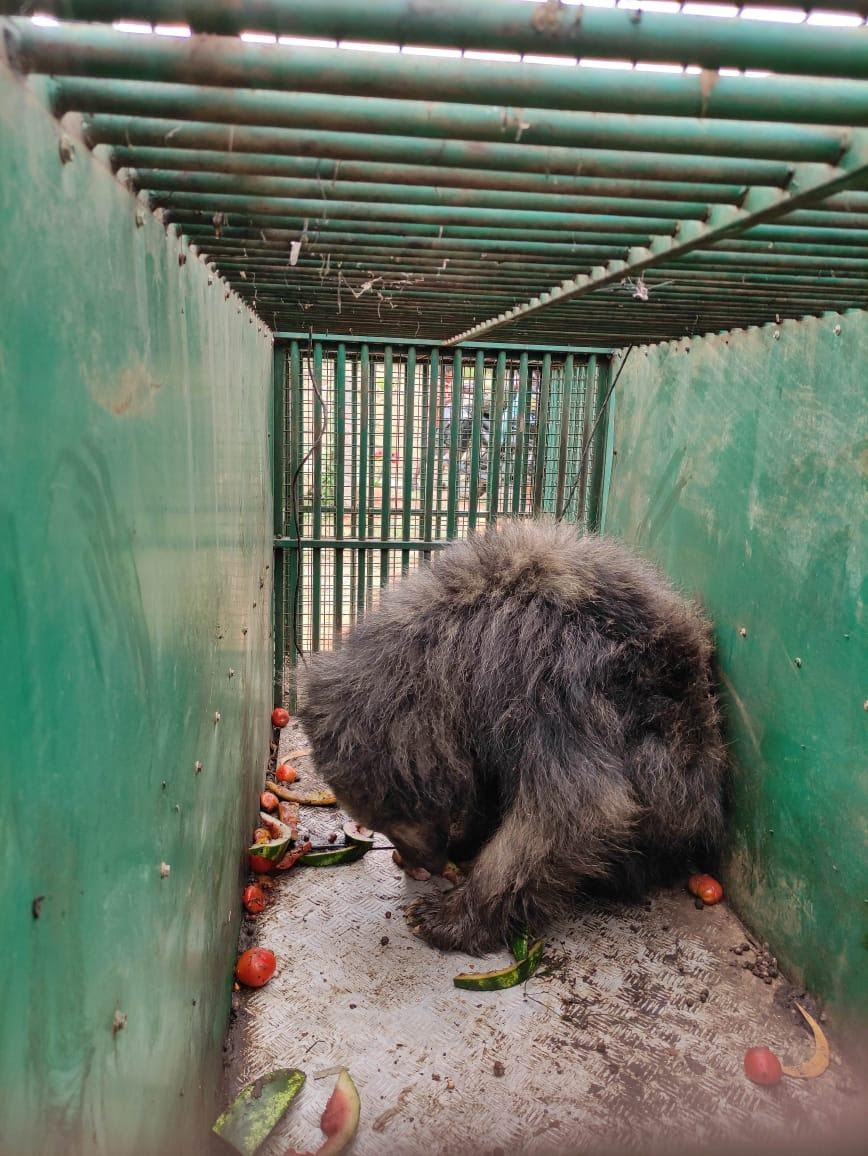Green minute
The hungry bear gobbled on more than 50 water melons and other fruits when she was rescued from a farmland in Karnataka in India. Rescue and rehabilitation of Sloth bears are becoming common in India due to fragmentation, loss of habitat and conflicts. The recent rescue of a Sloth Bear in Chikkamagaluru territorial forests of Karnataka signifies the need for protection of this species which has been cited as “Vulnerable” on the IUCN Red List.
On January 10th, a female bear was rescued in Gardanagiri in Kadur Range when it strayed from the forests and settled down in a coconut garden, thereby scaring the villagers. This place is actually very close to the proposed Arsikere Sloth Bear Sanctuary.
Kadur range in Chikkamagaluru territorial division which is home to a good population of sloth bears has been facing man-animal conflict on and off in the last decade. The range has seen both bears and humans suffering injuries and deaths. Last March, a 3-4 months old bear cub with injuries was found dead at K Bidare in Kadur.
Apart from this, Kadur range adjoining Arsikere range has a very healthy population of 60 bears, say forest officials and add in this regard, a fourth sanctuary has been proposed for bears. Last March, the Karnataka state wildlife board had approved in principle the formation of Arsikere Sloth Bear Sanctuary.
The 10,088.37-hectare proposed area will include reserve forests of Hirekallugudda, Ramenahalli, Chakanakatte in Arsikere range and two blocks from Gardangiri in Kadur range. Activists hope the proposal would be cleared soon and the sanctuary notified. This area where the bear was found is pretty close to the proposed sanctuary and so, it may receive protection, once it is notified by the state government.
Now coming to the rescue of this 18-year-old female bear that was hiding near Mallagatta village near Singatagere in Kadur taluk. Biramma, a coconut lady farm owner informed forest staff that a sloth bear had settled inside her farm house for the last 10 days.
So, on January 10, the Kadur range staff and the vet team swung into action to rescue the bear. The rescue team comprised Kadur range RFO Tanuj Kumar and veterinarian Dr Pruthvi along with a few forest staff. On inspection, the team found that it was an aged and injured bear and could not even move towards the staff who were keeping a vigil.
The decision to net the bear was taken as it could not be sent back to the forest since it was not in good health. Although the sloth bear was in no way a threat to the villagers but people were scared that the bear would move about the coconut farm.
Forest officials devised the traditional net trap method to rescue the bear with the forest staff being experienced. Even some locals helped to trap the bear in the net. Without using any tranquillization, the bear was captured successfully. Dr Pruthvi and his team later provided treatment and first aid to the animal as it had some wounds on its rear portion, maybe due to fights with another bear or a leopard.
Chikkamagaluru honorary wildlife warden G Veeresh added, “Conflict and wounded and aged sloth bears cannot be released into the forest as it would have created a bigger problem. If they are released into the wild, it would be a big problem for the people and for the animal. Further, a proper decision was taken by forest officials so as to tackle man-animal conflict and also not create resentment in the minds of local people.”
For two days, the bear was tended and looked after by the Anti-Poaching Camp staff at the Basur Kaval Black Buck Conservation reserve. Daily veterinary doctors treated and observed the bear. Since it was a hungry bear, more than 50 watermelons and other fruits was consumed by it.
Chikkamagaluru DCF Jagannath, ACF Muddanna and others were at the camp daily and finally after receiving the permission from higher authorities, the sloth bear was shifted to Atal Bihari Vajpayee Zoological park at Kamlapur in Hosapete taluk. Now the sloth bear is reported to be in good condition and keeping healthy in its new environs.
According to the DCF, this area is a very good habitat for sloth bears, foxes, blackbucks and other species and the people living in and around this area are very peaceful and tolerant and have not disturbed any species and have accepted the presence of these species in their midst sometimes.
Sloth bears are myrmecophagous which means they love eating termites and ants. In fact, roughly half of their diet in the wild is made up of termites and ants, the other half being a variety of fruits and seeds. Many of their unique characteristics are related to being myrmecophagous. They are the only species that regularly transports its young ones on its back. This is to ward off potential predators like tigers. Well, lets hope, the Sloth Bears in the coming days find more protection in the forests of India.

